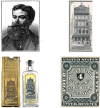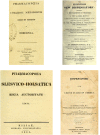Buchu (Agathosma betulina and A. crenulata): Rightfully Forgotten or Underutilized?
- PMID: 35197854
- PMCID: PMC8859318
- DOI: 10.3389/fphar.2022.813142
Buchu (Agathosma betulina and A. crenulata): Rightfully Forgotten or Underutilized?
Abstract
Today, the term buchu refers to the two species in commerce, Agathosma betulina (P.J.Bergius) Pillans and Agathosma crenulata (L.) Pillans (Rutaceae). Its traditional use in urinary tract infections and related ailments made it a popular remedy, specifically in the US, in 19th century, but with the advent of antibiotics it became largely obsolete. Recent focus is on technological use and on the essential oil for use in the perfume and food-flavouring industry. A review of the scarce pharmacological research revealed moderate antimicrobial activity for a leaf extract but not the essential oil of both species in the MIC assay. In the 5-lipoxygenase (5-LO) assay the essential oil of both species revealed IC50 values of 50.37 ± 1.87 μg/ml and 59.15 ± 7.44 μg/ml, respectively. In another study 98% inhibitory activity was determined for 250 μg/ml of an ethanolic extract of A. betulina on cyclooxygenase (COX)-1 and a 25% inhibitory activity on COX-2. Analgesic activity of an ethanolic extract of A. betulina was shown in mice. Moderate antioxidant activity was determined for methanol:dichlormethane extracts of A. betulina and A. crenulata and an aqueous extract of A. betulina showed a Trolox equivalent antioxidant capacity (TEAC) of 11.8 µM Trolox. Recent in vitro studies with a commercial aqueous extract of buchu revealed increased uptake of glucose added to 3T3-L1 cell line, significant inhibition of the respiratory burst of neutrophils and monocytes, reduction in the expression of adhesion molecules and inhibition of the release of IL-6 and TNF-α. In diabetic rats the ingestion of aqueous buchu extract completely normalized the glucose level and in rats receiving a high fat diet the consumption of aqueous buchu extract resulted in less weight gain and less intraperitoneal fat gain as well as reduction of elevated blood pressure to normal associated with cardioprotective effects. Limitations in the hitherto conducted research lie in the undisclosed composition of the buchu extracts used and the difficulty in extrapolating data from animal studies to humans. Health claims for buchu products need to be substantiated by randomized, double-blind and placebo-controlled studies. Only then can they be promoted for their true therapeutic potential.
Keywords: buchu; commercialization; ethnobotany; pharmacological activity; phytochemical composition.
Copyright © 2022 Brendler and Abdel-Tawab.
Conflict of interest statement
TB is an industry consultant DBA PlantaPhile and is part-time employed by Traditional Medicinals Inc. The remaining author declares that the research was conducted in the absence of any commercial or financial relationships that could be construed as a potential conflict of interest.
Figures






Similar articles
-
Safety and efficacy of a feed additive consisting of an essential oil from the leaves of Agathosma betulina (P.J. Bergius) Pillans (buchu leaf oil) for use in all animal species (FEFANA asbl).EFSA J. 2022 Mar 8;20(3):e07160. doi: 10.2903/j.efsa.2022.7160. eCollection 2022 Mar. EFSA J. 2022. PMID: 35281638 Free PMC article.
-
'Buchu' -Agathosma betulina and Agathosma crenulata (Rutaceae): a review.J Ethnopharmacol. 2008 Oct 28;119(3):413-9. doi: 10.1016/j.jep.2008.07.036. Epub 2008 Aug 3. J Ethnopharmacol. 2008. PMID: 18725278 Review.
-
Buchu (Agathosma betulina and A. crenulata, Rutaceae) essential oils: their pharmacological action on guinea-pig ileum and antimicrobial activity on microorganisms.J Pharm Pharmacol. 2001 Apr;53(4):579-82. doi: 10.1211/0022357011775703. J Pharm Pharmacol. 2001. PMID: 11341377
-
First Report of the Root-Knot Nematode Meloidogyne javanica on Buchu (Agathosma betulina) in South Africa.Plant Dis. 2004 May;88(5):574. doi: 10.1094/PDIS.2004.88.5.574A. Plant Dis. 2004. PMID: 30812672
-
Uzara (Xysmalobium undulatum) - An underutilized anti-diarrhoeic and spasmolytic herbal remedy.J Ethnopharmacol. 2024 Jan 10;318(Pt B):116999. doi: 10.1016/j.jep.2023.116999. Epub 2023 Aug 6. J Ethnopharmacol. 2024. PMID: 37549862 Review.
Cited by
-
A Review of the Green Synthesis of ZnO Nanoparticles Utilising Southern African Indigenous Medicinal Plants.Nanomaterials (Basel). 2022 Oct 3;12(19):3456. doi: 10.3390/nano12193456. Nanomaterials (Basel). 2022. PMID: 36234584 Free PMC article. Review.
-
Natural Substances vs. Approved Drugs in the Treatment of Main Cardiovascular Disorders-Is There a Breakthrough?Antioxidants (Basel). 2023 Dec 7;12(12):2088. doi: 10.3390/antiox12122088. Antioxidants (Basel). 2023. PMID: 38136208 Free PMC article. Review.
-
Cranberry-derived bioactives for the prevention and treatment of urinary tract infections: antimicrobial mechanisms and global research trends in nutraceutical applications.Front Nutr. 2025 Feb 26;12:1502720. doi: 10.3389/fnut.2025.1502720. eCollection 2025. Front Nutr. 2025. PMID: 40078413 Free PMC article.
-
Stevens' Cure (Umckaloabo)-the vindication of a patent medicine.Front Pharmacol. 2024 Jan 3;14:1294997. doi: 10.3389/fphar.2023.1294997. eCollection 2023. Front Pharmacol. 2024. PMID: 38235116 Free PMC article.
-
Propagation of Medicinal Plants for Sustainable Livelihoods, Economic Development, and Biodiversity Conservation in South Africa.Plants (Basel). 2023 Mar 3;12(5):1174. doi: 10.3390/plants12051174. Plants (Basel). 2023. PMID: 36904034 Free PMC article. Review.
References
-
- Afriplex (2008). Afriplex Buchu Cultivation Project. Paarl: Afriplex Pty Ltd. Google Scholar
-
- American Pharmaceutical Association (1888). The National Formulary of Unofficinal Preparations. Washington, DC: American Pharmaceutical Association. Google Scholar
-
- Anonymous (1847). Buchu in Anasarca. Prov Med. Surg. J. 11, 615. PubMed Abstract | Google Scholar - PMC - PubMed
-
- Anonymous (1912a). Cargo of Titanic Valued at $420,000 The New York Times. April 21, 1912. Google Scholar
-
- Anonymous (1835). Codex Medicamentarius Hamburgensis. Hamburg: Perthes. Google Scholar
Publication types
LinkOut - more resources
Full Text Sources
Research Materials

